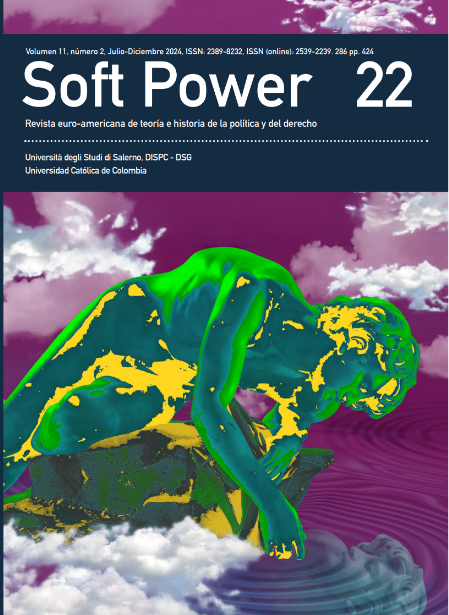
This work is licensed under a Creative Commons Attribution-NonCommercial 4.0 International License.
Al enviar los artículos para su evaluación, los autores aceptan que transfieren los derechos de publicación a Soft Power. Revista Soft Power para su publicación en cualquier medio. Con el fin de aumentar su visibilidad, los documentos se envían a bases de datos y sistemas de indización, así mismo pueden ser consultados en la página web de la Revista.Abstract
This paper, excerpted from Que faire de l’intelligence artificielle ? Petite histoire critique de la raison artificielle, offers an account and genealogy of artificial intelligence (AI)’s technical foundations and philosophical implications from its mid-20th-century origins
to the present. The narrative underscores how early scientific hypotheses continue to influence current AI paradigms. Part one uncovers foundational hypotheses—predating the 1956 Dartmouth workshop—that informed both symbolic AI (prevalent
until the late 1980s) and the surge of connectionist methods in recent decades, demonstrating their shared premise of mind and brain as logical machines. Part two examines the sociotechnical labor of AI development, using the ImageNet database as a case study to reveal the hidden work of crowdsourcing in training modern models. By juxtaposing these theoretical foundations with practical industry practices, the paper highlights enduring continuities and transformations in AI research and invites reflection on the technical and social processes shaping the AI industry today.

References
Cardon, D., Cointet, J.-P., & Mazières, A. (2018). La Revanche des neurones. Réseaux,5(211), 173–220. https://doi.org/10.3917/res.211.0173.
Casilli, A. A. (2019). En attendant les robots : Enquête sur le travail du clic. Seuil.Dreyfus, H. L., & Dreyfus, S. E. (1988). Making a Mind versus Modeling the Brain: ArtificialIntelligence Back at a Branchpoint. Daedalus, 117(1), 15–43.
Dupuy, J.-P. (2009). On the Origins of Cognitive Science: The Mechanization of the Mind(M. B. DeBevoise, Trans.). MIT Press.
Ekbia, H. R., & Bonnie, N. (2017). Heteromation, and Other Stories of Computing and Capitalism. The MIT Press.https://doi.org/10.7551/mitpress/10767.001.0001
Gray, M. L., & Suri, S. (2019). Ghost Work: How to Stop Silicon Valley from Building a New Global Underclass. Houghton Mifflin Harcourt.
Haugeland, J. (1989). Artificial Intelligence: The Very Idea. MIT Press. https://doi.org/10.7551/mitpress/1170.001.0001
ImageNet. (2021, March 11). About ImageNet. https://image-net.org/about.php
Levin, J. (2023). Functionalism. In E. N. Zalta & U. Nodelman (Eds.), The Stanford Encyclopedia of Philosophy (Summer 2023). Metaphysics Research Lab, Stanford University.https://plato.stanford.edu/archives/sum2023/entries/functionalism/
Markoff, J. (2012). Seeking a Better Way to Find Web Images. The New York Times.https://www.nytimes.com/2012/11/20/science/for-web-images-creating-new-technology-to-seek-and-find.html
McCulloch, W. S. (1965). Mysterium iniquitatis of sinful man aspiring into the place ofgod. In Embodiments of Mind (pp. 157–164). MIT Press. https://archive.org/details/embodimentsofmin0000mccu/page/n13/mode/
Mumford, L. (1970). The Myth of the Machine: The Pentagon of Power (Vol. 2). Harcourt
Brace Jovannich.
Newell, A., & Simon, H. A. (1976). Computer Science as Empirical Inquiry. Communications of the ACM, 19(3), 113–126. https://doi.org/10.1145/360018.360022
Pontin, J. (2007). Artificial Intelligence, With Help From the Humans. The New York Times. https://www.nytimes.com/2007/03/25/business/yourmoney/25Stream.html
Princeton University. (n.d.). *WordNet 3.1 dictionary files* [Data set]. https://wordnetcode.princeton.edu/wn3.1.dict.tar.gz
Proust, J. (1987). L’Intelligence artificielle comme philosophie. Le Débat, 47(5), 88.https://doi.org/10.3917/deba.047.0088
Taylor, A. (2018). The Automation Charade. Logic(S), (5). https://logicmag.io/failure/the-automation-charade/
Triclot, M. (2005). Penser c’est calculer : éléments pour une préhistoire de l’informatique.https://hal.science/hal-01526653/document
Turing, A. M. (1937). On Computable Numbers, With an Application to the Entscheidungsproblem.Proceedings Of The London Mathematical Society, s2-42(1), 230–265.https://doi.org/10.1112/plms/s2-42.1.230k









